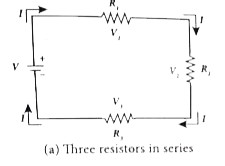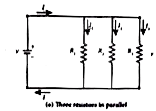Explain the equivalent resistance of a series and parallel resistor network. Solution in Tamil
Resistors in series :
R1,R2,R3- Resistors connected in series
V = potential applied
In series, the current flowing throw the resistors is same.
Potential across R1,R2,R3 are V2,V2,V3
repectively.
Total voltage V=V1,V2,V3
According to ohm.s law V=IR1,V2,IR2,
V=IR3,V=IRs
V=IR1+IR2+IR3
IRs=I(R1+R2+R3)
(Equivalent restance ) Rs=R1+R2R3

(a) three resstors in series

The equivalent resistance of a series is the sum of the individual resistances.
Rs is always greater then each individual resistance.
Resistor in parallel :
R1,R2,R3, -Resistances connected in parallel
V - Applied voltage.
In parallel the voltage across each rasistor is same.
Current in resistor R2,R2 and R3 are I1,I2,I3 respectively,
According to Ohm.s law :
I1=VR1,I2=VR2,I3
VR3,I=VRP
VRp=VR1+VR2+VR3⇒VRp=V(1R1+1R2+1R3)
1Rp=1R1+1R2+1R3
Rp equivalent resistance of the parallel combination of resistors. The sum of the reciprocal of effective resistance.
Rp is lesser than each individual, resistance.
Similar Questions
Find the equivalent resistance of the two resistors connected in parallel series.
View SolutionThe equivalent resistance of network of three 2Ω resistors can not be
View SolutionThe equivalent resistance of network of three 4Omega resistors can not be
View SolutionExplain series connection of resistors. Derive equation of equivalent resistance (RS).
View SolutionThe equivalent resistance of a series combination of two resistors is '9 Omega' and the equivalent resistance of a parallel combination of the same two resistors is 2Ω. Find the resistances of the resistors.
View Solutionदिए गए चित्र में प्रतिरोधों के नेटवर्क का समतुल्य प्रतिरोध होगा

View SolutionTwo resistors are connected (a) in series (b) in parallel. The equivalent resistance in the two cases are 9 ohm and respectors. Then the resistances of the component resistors are
View SolutionThe equivalent resistance of n identical resistors connected in parallel is x. If the resistors are connected in series, the equivalent resistance would be
View Solution